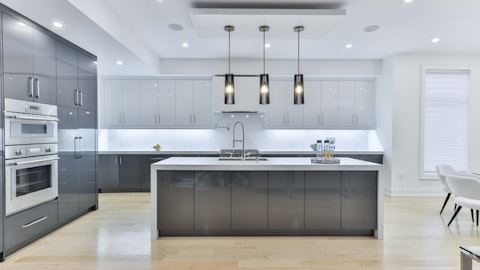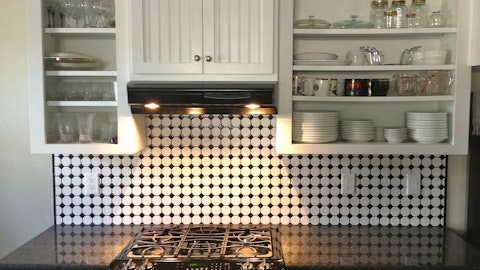American Woodmark Corporation (NASDAQ:AMWD) Q3 2024 Earnings Call Transcript February 29, 2024
American Woodmark Corporation beats earnings expectations. Reported EPS is $1.66, expectations were $1.13. AMWD isn’t one of the 30 most popular stocks among hedge funds at the end of the third quarter (see the details here).
Operator: Good day everyone, and welcome to the American Woodmark Corporation Third Fiscal Quarter 2024 Conference Call. Today’s call is being recorded February 29, 2024. During this call, the Company may discuss certain non-GAAP financial measures included in our earnings release, such as adjusted net income, adjusted EBITDA, adjusted EBITDA margin, free cash flow, net leverage, and adjusted EPS per diluted share. The earnings release, which can be found on our website, americanwoodmark.com, includes definitions of each of these non-GAAP financial measures. The Company’s rationale for their usage, and the reconciliation of these non-GAAP financial measures to the most comparable GAAP financial measures. We also use our website to publish other information that may be important to investors, such as investor presentations.
We’ll begin the call by reading the Company’s Safe Harbor statement under the Private Securities Litigation Reform Act of 1995. All forward-looking statements made by the Company involve material risks and uncertainties and are subject to change based on factors that may be beyond the Company’s control. Accordingly, the Company’s future performance and financial results may differ materially from those expressed or implied in any such forward-looking statements. Such factors include, but are not limited to, those described in the Company’s filings with the Securities and Exchange Commission, the annual report to shareholders. Company does not undertake to publicly update or revise its forward-looking statements, even if experience or future changes make it clear that any projected results expressed or implied therein will not be realized.
I would now like to turn the floor over to Paul Joachimczyk, Senior Vice President and CFO. Please go ahead, sir.
Paul Joachimczyk: Good afternoon and welcome to American Woodmark’s third fiscal quarter conference call. Thank you for taking the time today to participate. Joining me is Scott Culbreth, President and CEO. Scott will begin with a review of the quarter and I’ll add additional details regarding our financial performance. After our comments, we’ll be happy to answer your questions.
Scott Culbreth: Thank you, Paul, and thanks to everyone for joining us today for our third fiscal quarter earnings call. Our teams delivered net sales of $422.1 million, representing a decline of 12.2% versus the prior year. Within New Construction, our net sales declined 11% versus the prior year. Recent data points such as housing starts and NAHB’s measure of builder sentiment point to improving demand as we head into the spring. We remain strategically aligned with 19 of the top 20 national builders and key regional builders. With our best-in-class direct service model, we plan to continue to grow our share with new and existing customers and benefit from the share gains our partners are realizing in the marketplace. Looking at Remodel, which includes our Home Center and Independent Dealer and Distributor businesses, revenue declined 13.1% versus the prior year.
Within this, our Home Center business was down 14.1% versus the prior year. Demand trends remain under pressure due to lower in-store traffic rates and consumers choosing smaller-sized projects. With regards to our Dealer and Distributor business, we were down 10.3% versus the prior year. Our adjusted EBITDA decreased 0.7% to $50.6 million, but our adjusted EBITDA margin percentage increased 140 basis points to 12% for the quarter. Reported EPS was $1.32 and adjusted EPS was $1.66. The improvement in performance is due to product mix and improved efficiencies in the manufacturing platforms. Our team continues to drive operational excellence in our plans. Our cash balance was $97.8 million at the end of the third fiscal quarter and the company has access to an additional $322.9 million under its revolving credit facility.
Leverage was reduced to 1.5 times adjusted EBITDA and the company repurchased 216,000 shares in the quarter. Our net sales outlook for fiscal year ’24 remains unchanged with our expectation of a low double-digit decline with fiscal Q4 sales down high single-digits. Due to the strong fiscal third quarter performance, our adjusted EBITDA expectations for the full fiscal year is increasing and narrowing to a range of $247 million to $253 million. Our team continues to execute against our strategy that has three main pillars; growth, digital transformation and platform design. Growth will benefit from the launch of a low-skew, high-value offering in the Home Center’s targeting pros and a new brand that will serve our distribution customers 1951 Cabinetry.

Our made-to-order business will also benefit from the upcoming summer launch, featuring new on-trend styles and finishes. Digital transformation efforts over the last fiscal quarter include the go-live of ERP and Monterrey, the go-live of WMS in Hamlet, North Carolina, and the go-live of website enhancements for our Home Center business. The planning for the next phase of work continues and includes the CRM service module supporting our customer care organization and new construction service center operations and ERP for our made-to-stock facilities. Platform design work continues with our first shipment of components from Monterrey, Mexico in January, and shipments of bath products from our Hamlet, North Carolina location in February. We will continue equipment installations in the coming months along with the training and hiring of new teammates to support our ramp plan.
In closing, I’m proud of what this team accomplished in the third fiscal quarter and look forward to their continuing contributions during fiscal year ’24. I will now turn the call back over to Paul for additional details on the financial results for the quarter.
Paul Joachimczyk: Thank you, Scott. Reviewing our third quarter results for fiscal year 2024. Net sales were $422.1 million, representing a decrease of $58.6 million or 12.2% versus prior year. Remodel net sales, which combines Home Centers and Independent Dealer and Distributors, decreased 13.1% for the third quarter versus prior year, with both Home Centers and Independent Dealer Distributors decreasing 14.1% and 10.3%, respectively. New Construction net sales decreased 11% for the quarter compared to last year. Our gross profit margin for the third quarter of fiscal year 2024 improved 350 basis points to 19.2% in net sales versus 15.7% reported in the same period last year. Gross margin benefited from favorable product mix and pricing matching, inflationary costs impacts along with operational improvements in our manufacturing facilities combined with the stability in our supply chain.
Total operating expenses, excluding any restructuring charges for the third quarter of fiscal year 2024 was 12.6% of net sales versus 10.4% for the same period last year. The 220 basis point increase is due to increases in our incentives and profit sharing for all employees and lower sales. Adjusted net income was $26.8 million, or $1.66 per diluted share in the third quarter of fiscal year 2024 versus $24.4 million, or $1.46 per diluted share last year. Adjusted EBITDA for the third quarter of fiscal year 2024 was $50.6 million, or 12% of net sales versus $51 million, or 10.6% of net sales, reported in the same period last year and represents a 140-basis-point improvement year over year. Despite facing year-to-date volume headwinds, our continued strong earnings performance this year is a direct result of the hard work and efforts our teams have put into reestablishing and maintaining our operational efficiencies, stabilizing our supply chain, and controlling overall spending.
These earning gains are partially offset by increases in incentive compensation, profit sharing, and digital transformation costs. Free cash flow totaled a positive $131.7 million for the current fiscal year to date compared to $91.5 million in the prior year. The $40.2 million increase was primarily due to changes in our operating cash flows, specifically higher net income and lower inventory partially offset by increased capital expenditures. Net leverage was 1.5 times adjusted EBITDA at the end of the third quarter of fiscal year 2024, representing a 0.76 improvement from the 1.81 times as of last year. As of January 31, 2024, the company had $97.8 million of cash and cash equivalents on hand, plus access to $322.9 million of additional availability under our revolving facility.
Under the current share repurchase program, the company purchased 19.6 million, or approximately 216,000 shares, in the third quarter, representing about 1.3% of outstanding shares being retired. For the first nine months, we have repurchased 71.8 million of the company’s common shares and have 105.4 million of share repurchase authorization remaining. Our outlook for the fiscal year 2024 from a net sales perspective, we continue to expect low double-digit declines in net sales versus fiscal year 2023, with high single-digit declines in the fourth fiscal quarter. The change in net sales is highly dependent upon overall industry, economic growth trends, material constraints, labor impacts, interest rates, and consumer behaviors. Given our strong performance for the first nine months of the year, we are increasing and narrowing our adjusted EBITDA expectation for the full fiscal year 2024 to a range of $247 million to $253 million.
The increase in our expected outlook is due to the strong operational performance and the execution we have achieved in the first nine months of our fiscal year 2024. Reiterating our outlook from the past quarter, we have begun operations in our new locations in Hamlet, North Carolina, and Monterrey, Mexico, and we’ll continue to ramp up production throughout the remaining calendar year. This will negatively impact our results and we will be incurring operational expenses without the offsetting full revenue performance of those locations. The total impact of these charges is approximately $8 million to $9 million in the full fiscal year 2024, with more than half of these charges occurring in the fourth fiscal quarter. In closing, our business continues to capitalize on the strides achieved over the past year.
We anticipate that these enhancements will positively impact our financials throughout the remainder of the fiscal year. This success stands as a testament to the unwavering commitment, diligence and contributions of our dedicated employees, all in alignment with our GDP strategy. I extend my heartfelt gratitude to every team member at American Woodmark. They are the driving force behind our daily accomplishments. They are the ones who make could happen daily. This concludes our prepared remarks. We’ll be happy to answer any questions you have at this time.
See also 20 Countries with Most Bombers and Superior Air Force and 13 Highest Paying Countries for Marine Biologists.
Q&A Session
Follow American Woodmark Corp (NASDAQ:AMWD)
Follow American Woodmark Corp (NASDAQ:AMWD)
Operator: At this time, we’ll begin the question-and-answer session. [Operator Instructions] Our first question today comes from Garik Shmois from Loop Capital. Please go ahead with your question.
Garik Shmois: Oh, hi. Thanks. And congrats on the quarter. I was hoping you can go into a little bit more detail on what you’re seeing on the Remodel side, in particular, if you can provide some detail around in-stock versus semi-custom.
Scott Culbreth: Yes, Garik. Good afternoon. So when we look at the Remodel business, we’re not seeing any major differences across the categories from a sell-through rate standpoint. So in stock as well as the special order in the Home Centers performed comparably inside the period.
Garik Shmois: Got it. Wondering if you could go into some more detail. I think you talked about an improvement in product mix. What was driving that?
Scott Culbreth: That would be mixed across our channels first and foremost. So what we sold through in each of the respective channels that we’ve got, we’ve seen really an ability to hang on to the overall mix. I know there was some speculation going into this most recent fiscal year, perhaps rotation down. We’ve really not experienced that across the new construction channel. We’ve seen a little bit of that inside Remodel, but in totality, a favorable mix equation for us inside the quarter.
Garik Shmois: Got it. And then I know we’re not in your fiscal ’25 yet, but if you’re able to share any thoughts on how you think, perhaps, maybe calendar ’24, just maybe a longer-term view of the market. I think we heard from a competitor, you know, anticipating low single-digit market growth declines over the next, say, four quarters. Just curious if you have any similar observations or any deviation off of that.
Scott Culbreth: Sure. And you’re right. We’re not ready to share an outlook beyond fiscal year 2024. You know, our cycle is, we’re really starting our budgetary meetings internally now. We’ll be ready to give you a full fiscal year ’25 outlook in our next call. With that said, what are we hearing and seeing in the market, certainly, there was a number of recent releases in the building product space, across competitors, other categories, customers, and then, of course, the show out in Vegas this week. So if I take all of those inputs together, I think what we’re seeing and hearing is that the range for single-family starts is still a bit mixed. We’re seeing analysts talk about low- to and mid-single-digit growth for the calendar year.
I think Remodel is the one that continues to remain a bit under pressure, estimates there from low- to mid-single-digits on the negative side. Home Centers again just reported their figures for the year and their outlook on calendar year ’24, both signaled negative comps in the calendar year. And certainly, for the last two quarters, they both signaled that our category was performing worse than that. So, if I was to take all of that together, I would say that in totality Repair & Remodel, call it down low to mid-single, and then New Construction up mid-single, I think is sort of the market view. Our perspective in this would be the same as it’s been for many years, is that we should perform better than that in both New Construction, Repair & Remodel.
So, I’m not yet ready to give you what that translates into an outlook, but that’s at least the market view. And our expectation is that we’ll gain share and perform better than that.
Garik Shmois: No, that makes sense. All right. Thanks for all that. I’ll pass it on.
Scott Culbreth: Okay. Thank you.
Operator: Our next question comes from Steven Ramsey from Thompson Research Group. Please go ahead with your question.
Steven Ramsey: Hi, good evening. Wanted to think about, you know, looking out over the next 12 months and with the new facilities now up and running, curious how adaptable you are to run those and ramp production up or down as the demand profile rolls in and how that potentially impacts gross margins as going forward with the new facilities coming online.
Scott Culbreth: Yes. Specifically to the first part of the question on our ability to adapt and ramp up or ramp down production, our operations team has historically done a fantastic job of being able to do that. During COVID, our biggest barrier would have been labor. We certainly have seen a better labor environment, but our beliefs internally is that that’ll continue to always be a challenge. So we’ve done a lot of work over this past year to make sure we’ve got more flexibility and capability to ramp up as needed. And of course, ramping down, quite frankly, a little bit easier in that scenario. Specific to that capacity, you know, our commercial teams are doing a great job working in the market on finding opportunities for us to be able to fill that capacity. I don’t know exactly when we’ll get to a full ramp from that perspective. And that’ll be part of our outlook conversation that we’ll share with you all again next quarter.
Steven Ramsey: Okay. That’s helpful. And then thinking about signals you’re maybe looking at for Repair & Remodel and a potential recovery there. Do you look first at trends through the dealer channel, through Home Centers. Just curious if there’s anything in the marketplace that you’re looking for that may not be publicly stated from others in their outlook.
Paul Joachimczyk: Nothing materially different from what you see in the marketplace. I would say that we’re looking at other data points outside of those outlets first. So what’s happening with existing home sales, of course, that creates an opportunity for a transaction. What’s happening with consumer sentiment, their willingness to invest back in the home and spend dollars, are they going to shift away from experiences back to an investment in an asset they own? What’s happening with interest rates? So the same things you’re viewing are the things that we’re going to look at there. Depending on the cycle, we’ve seen different channels come back faster. So, I don’t want to point to Dealer as a leading indicator, and I don’t want to point to Home Center as a leading indicator because they both have varied over the years. So we look at the outside factors and then keep our eye around both of those particular outlooks as to the type of activity and jobs they’re bidding.
Steven Ramsey: Okay. That’s helpful. And then last quick one for me, the margin outlook raised, just to make sure that’s from already produced results year to date, or is there anything in the Q4 outlook that helps to bolster that full-year guide?





